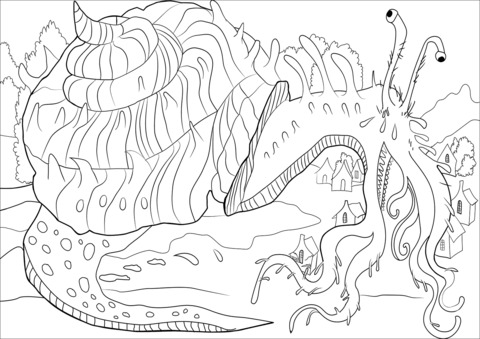#lou carcolh
Text
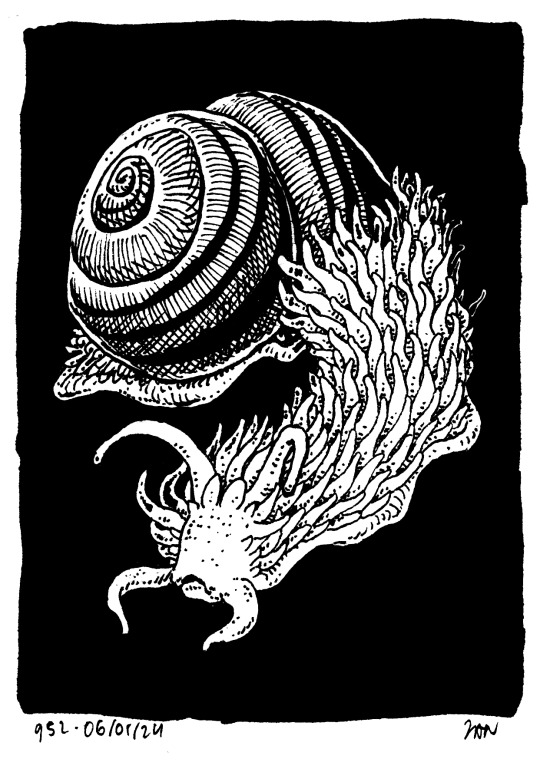
Carcolh, the 238th Known One.
#carcolh#lou carcolh#France#Gascogne#idk why i thought it was some kind of dragon but... not at all#just a hairy slug#i interpreted the hairy like this but i wonder if it wouldnt but good with just fur ahah#nudibranch#snail#Europe#monster#chimera#bestiary#creature design#ink#the Known Ones#952#octem 119#aqva 4
204 notes
·
View notes
Text
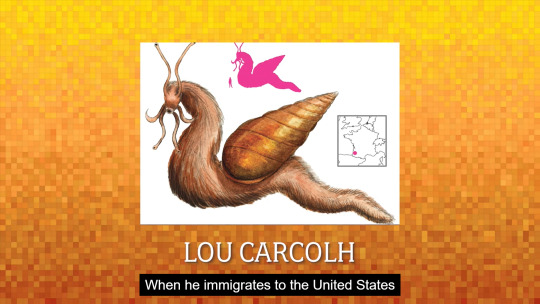


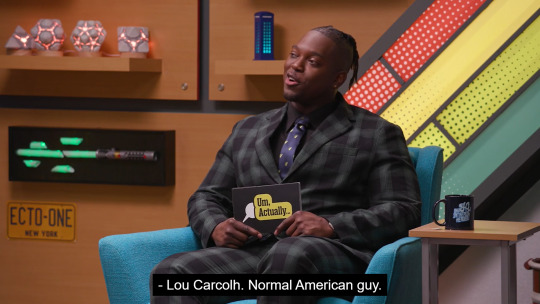
Normal American Guy.
111 notes
·
View notes
Text

I must say that animals are quite the architects sometimes. I feel like it doesn't get acknowledged enough. Us sapient species like to pretend that we are the only ones who do it, that no simple creature could ever achieve such a thing. But look at the intricate nests of birds, the incredible spires of the Mountain Makers and the gorgeous weaving of spiders! How can we pretend these are inferior? Each are so beautiful in their own right, and impressive in their design and complexities! I would say that there are many animals out there that earn the title of "builder" and "architect." In the case of the Mason Maw Carcolh, it is right in the name!
Mason Maw Carcolhs are certainly a member of the Carcolh family, being large shelled mollusks who are known for their impressive size, appetite and adaptations. The Mason Maw is one that shares a similar range with the regular Lou Carcolh, though they tend for rockier areas, but there is no way you would ever get the two confused! First off is that blazing orange color they have! Quite gorgeous and eye catching! Then comes their shell, or what stands in place of their shell. Mason Maws do have shells like the majority of their family, but you rarely ever see them because they are always buried beneath these odd stone constructions. In fact, a whole lot of the Mason Maw is covered in these rocky plates and growths! What's the deal? Do they carve stone and wear it like armor? Not really! The secret behind these structures can be found with the Mason Maws.....well....maw.
These carcolhs have a noticeable pouch formed around their radula, and here the snail produces copious amounts of a gray sticky substance. This paste-like gunk is referred to as "mortar," and the carcolh fills this pouch with as much as it can carry! Maybe that should tell you about the origins of their name, eh? Obviously, though, mortar in the mouth doesn't explain how they have all this stuff on their shell and back. To figure out how that happens, just look to their oral tendrils. Unlike the Lou Carcolh, these aren't nearly as hairy or sticky, and they have special structures on their ends. Any builder or mason would recognize these shapes in an instant! They are the tools the carcolh uses to scoop mortar out of its mouth and spread it onto whatever surface it wants, be it the earth or its own body! Once the mortar is removed from its moist radula pouch, it will begin to dry and harden at a rapid rate. It can turn rock-like in only a few minutes, which means the Mason Maw must work fast! But once it does finish drying out, it can be just as tough as stone! Quite useful, and for a variety of reasons!
Just like its other brethren, the Mason Maw likes to take its prey by surprise. At the speed these snails move, you can certainly rule out the tactic of pursuit. These ones use their stony exterior to blend in with surrounding rocks and landscape, remaining perfectly still as it waits for food. How it catches prey can vary depending on the situation. In most cases, the Mason Maw vomits out a whole bunch of mortar onto its victim when they get close, and the paste sticks fast to fur and hide. The weight and stickiness alone can slow food down enough for the tendrils to grab hold and reel them in. Even if they run, it won't take long for the stuck on mortar to harden. Victims will find themselves slowly petrifying, as their limbs get locked up from the hardening mortar and the weight becomes too much to carry. In minutes, they will be rendered a partial statue, trapped in this stony cocoon as the Mason Maw slowly follows their trail. I can't imagine how terrifying it would be, being stuck in these stone shoes as you watch your painful demise creep towards you inch by inch.
In other cases, the Mason Maw may set a trap. They can either find a shallow hole in the environment or dig one out with their tendrils. Whichever is the case, they then fill the hole with mortar til it is almost level with the rest of the earth. They will then apply a special mucus coating to this pit of gunk, which forms a layer that prevents it from hardening too fast. This mucus is used on their body in places they don't want the mortar to form, that way they don't get bogged down or trap their own movements. The Mason Maw may cover this layered puddle with loose vegetation or dirt, or they may leave it as is. With the mucus layer on top, it gives the reflective look of a pool of water. They then wait, and hope that prey trundles by and steps on this spot. When they do, their limbs will punch right through the disguise and moistening mucus, and straight into the sticky mortar. They will suddenly find themselves in a makeshift tar pit, struggling to get free. This is usually enough for the carcolh to slink out of its hiding place and take them down. No matter how you are caught, death by shredding against their razor toothed radula is certain.
This mortar sure is handy for making traps and catching prey, but what else can it do? Just look to its shell and see the answer! It is great for defense, creating stone hard plates and rocky armor. The Mason Maw layers its back with mortar to create this intricate armor, which protects it from predators. This prevents the Mason Maw from retracting into its shell, but it seems to work just as good! And speaking of shell, that impressive mass of sculpted mortar is their masterpiece! All Mason Maws use their mortar and tendrils to build upon their shells and create unique pieces of art! While it certainly works great for defense, it is also believed to show off strength, health and win over mates! I have to imagine there is a bit of pride in it too! While they certainly use mortar for the majority of their construction, they also like to add extra bits to it. Shiny rocks, leftovers from prey, random pieces of pretty junk, and even old armor and weapons! Infamous Mason Maws tend to have the armor and blades of knights and slayers built into their shell spires, carried like trophies of previous battles.
Some stories claim that the Mason Maw may trap live prey within these constructs as well! It seems improbable, but they do have paralytic venom and the mortar cures pretty quick. It is probably a rare scenario, but certainly a horrifying one! Imagine being carried around like a piece of jewelry, waiting to be freed by either heroes or death! Pretty freaky! Mason Maws work on these shell sculptures their entire lives, always adding to it or repairing it when needed. In some cases, the carcolh may be so old and intent on making its sculpture bigger that it can trap itself under its own weight! Making a shell too heavy to even carry! If this happens, the carcolh is kind of doomed unless something breaks enough chunks off to lighten the load, or if enough prey is dumb enough to walk right in front of the trapped snail.
Now you may be wondering what society thinks of these strange snails and their intricate sculptures. They are still flesh eating mollusks who won't hesitate to go after any meat in front of them, but do these ones differ in any way? Why yes they do! In fact, humans worship these incredible snails! Take another look at that shell and the mortar creations. Look familiar? Why, it looks like a castle! And humans build castles too! You seeing the link here? Indeed, humanity learned all they know about masonry and rock stacking from these incredible snails, whose unique adaptations ignited a whole new era for humanity. They saw the wondrous mortar and witnessed its use in building great spires and binding one rock to another. From there they were inspired, and they wound up creating the very castles and walls you see to this very day! Why, it is hard to imagine what would have happened to man if they never met a Mason Maw! Would they have ever stumbled upon the secret technique of sticking two bricks together? Well, I think....that I am totally messing with you.
No, humans did not learn how to build stone structures from Mason Maws, I was just being a goof. It is mainly because I keep reading about stuff where some people love to attribute great creations to anyone and anything save for the people who actually made them. They love their fantastical ideas of knowledge from the gods or secret magics lost to time, all while the folk that put in the time and effort to actually construct these things get ignored. Kind of awful, if you ask me. So that is why I did the whole "humans couldn't have possibly built castles on their own thing." Wait, should I be explaining the joke? Probably not, but it wasn't the greatest one to begin with...
So what do people actually think of Mason Maws? They think they are impressive and intriguing when they are a good distance away and not ambushing travelers or livestock. Their shells are admired for their incredible structure and arrangement of random pieces, to the point where empty ones are displayed like art. Some folk even hunt Mason Maws to get the goods that are buried inside all that hardened mortar. I recall a tale where a jewel thief was escaping the law with a whole sack full of goodies when they fell into a Mason Maw trap and were devoured. The stolen stash was then added to the snail's personal artwork, suddenly making it priceless! A whole number of slayers, knights and folk eager for lots of money went running after that unwary snail! The poor thing! It was probably so confused why it was suddenly the most "popular" carcolh around! Sadly, I don't think these people came to admire its craftsmanship!
Chlora Myron
Dryad Natural Historian
---------------------------------------------------
Hey, since its August, that means its Smaugust! So that means I am going to aim to be posting dragons! So here's one! Another snail dragon! Though it isn't exactly called that. And yes carcolhs aren't dragons. Certainly not True Dragons! Look do you want the snail or not?!
92 notes
·
View notes
Text
A colossal beast from Librum Prodigiosum! Lou Carcolh, a giant snail monster from French folklore! It’s long, extensive, and slimy tentacles can reach out for miles to snag unsuspecting victims and devour them!

#digital art#digital illustration#fantasy#art#folklore#mythology#librum prodigiosum#monster#mythical creatures#creature#artists on tumblr#mythology art#snail#mythologyart#Lou Carcolh#french mythology
65 notes
·
View notes
Text

‘Accept Your Prophecy’
Soundtrack:
Inspired by the movie/magazine Heavy Metal and the French cryptid Lou Carcolh.
#artists of tumblr#dark art#illustration#illustration artists#dark artist#horror art#horror artist#nightmare art#nightmare artist#Lou Carcolh#cryptid#cryptid art#heavy metal#folklore art#folklore#surrealist illustration#fantasy artist#fantasy character#fantasy art#lorna shore#Spotify
13 notes
·
View notes
Text
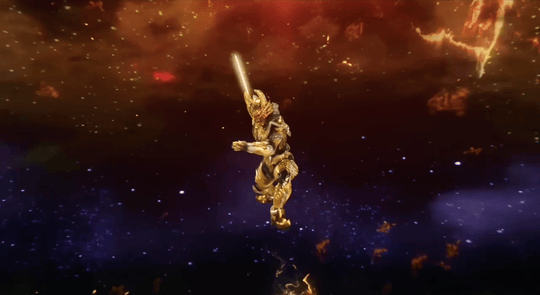

Garo vs. Lou Carcolh
7 notes
·
View notes
Text
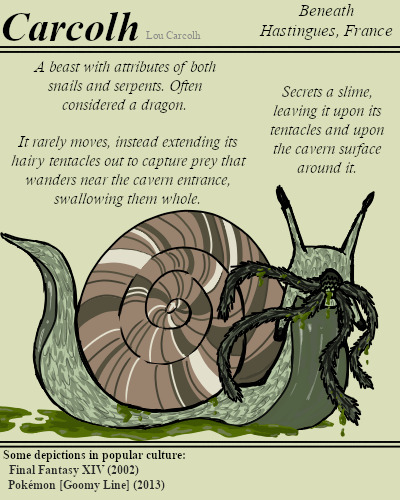
A massive sedentary predator that dwells within a cavern below a town in France. Its extending tentacles grab unwitting prey that may merely be passing by. Patience and a long, long reach are all the creature requires.
#BriefBestiary#bestiary#digital art#fantasy#folklore#legend#myth#mythology#french folklore#french myth#dragon#dragon snail#carcolh#lou carcolh#hastingues#monster snail#mythical creatures#monster
36 notes
·
View notes
Text
The Lou Carcolh is a mystical creature from the French folklore. "Carcolh" means snail in Occitan language 🐌
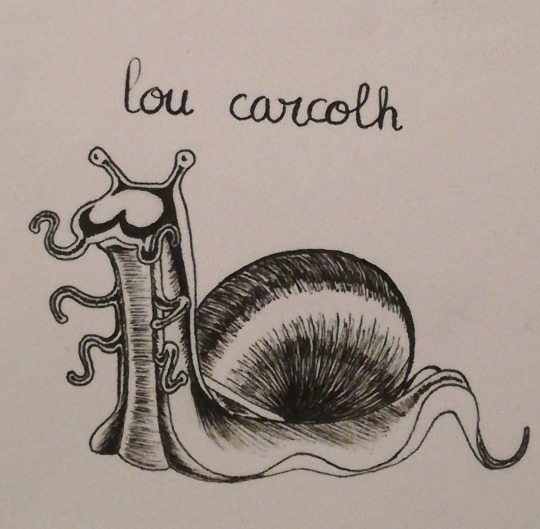
This (not so) little guy hides in caves and swallow lost animals whole... Maybe don't hang out in caves 😬
1 note
·
View note
Text
Happy Halloween!

2 notes
·
View notes
Text
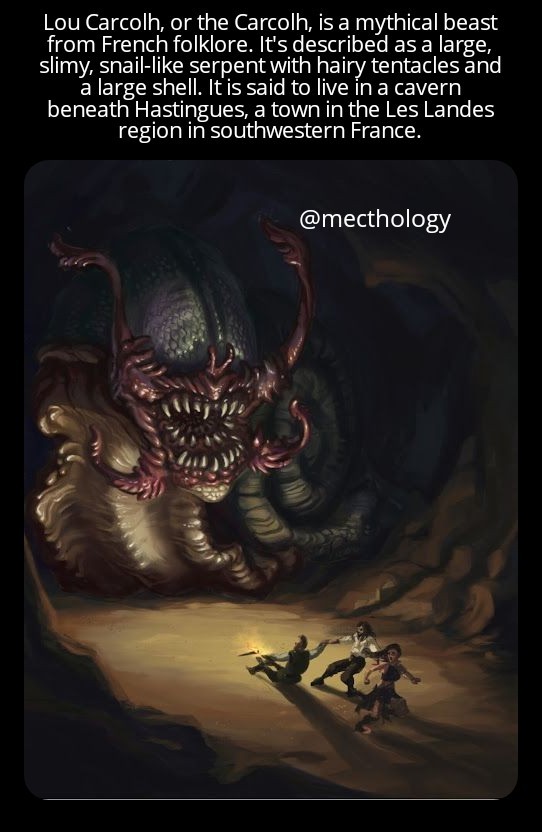
Lou Carcolh from French folklore.
Its gaping mouth was surrounded by several long, hairy, and slime covered tentacles that could extend for miles. These appendages stretched out from the cave it inhabited for a long distance and laid upon the ground among its own viscous slime. They would ensnare and drag back to its anybody anything within reach. It would then swallow the victim whole with its gigantic mouth.
Fortunately, the Carcohl wasn’t a fan of daylight, passing most of its time resting in its underground lair, surfacing only to hunt.
Rumor has it a merchant once dared enter the Carcolh lair and stole some of its eggs. He took such eggs with him when traveling to the New World, but the eggs were lost or stolen before he arrived. Some say that one of those eggs floated all the way to Grenhaven, hatching near the dark hemlock hills that surround the port, explaining some local legends about a giant carnivore snail haunting a section of the forest called Leeds Hop.
The Carcohl hasn’t been seen in more than 50 years, which many think indicates the beast has died. Other, less optimistic, people, prefer to believe the beast is alive but in deep hibernation waiting for a mate.
Follow @mecthology for more legends and lores.
DM for pic credit.
Source: Wikipedia, cryptidzfandom.com, mythicalcreaturescatalogue.com
54 notes
·
View notes
Text

Couldn't finish Goretober (lost interest in the prompts tbh), and things got busy anyway. But that's just how the holidays are.
Happy Halloween! It was fun doing some research on what the Crew would be dressing up as, though some were harder than others (mostly Abena's, which I had to take some liberties for). Here they are, dressed as beasts, ghouls, or spirits from their homeland folklore and mythologies:
Captain Frascona: The Dip, from Catalonia
Abena: The Asanbosam/Sasabosam, from the Akan people
Guy: Jean de l'Ours (I initially thought of doing the Beast of Gévaudan, but it would be too visually similar to the Dip), France
Phoebus: The Lou Carcolh, France
Rashid: The Shaitan, Arabian Peninsula
Ruixiong: The Jiangshi, China
Giovanni: The Bombasin, Venetian lagoon
And of course, the spooky Jack O' Lantern turnip, because those are super cool and sadly underrated.
If I got anything here wrong, feel free to let me know!
9 notes
·
View notes
Text
((Me sitting here with a board full of red string.
The original Hydro sovereign was supposedly a Hydro vishap. Melusines are apparently like an evolved form/new version of Hydro vishaps. Melusines are partially based off sea slugs. The Lou Carcolh thing that Goodra is based off is part mollusk. Slugs are mollusks.
Neuvillette really is the only male Melusine.))
2 notes
·
View notes
Photo
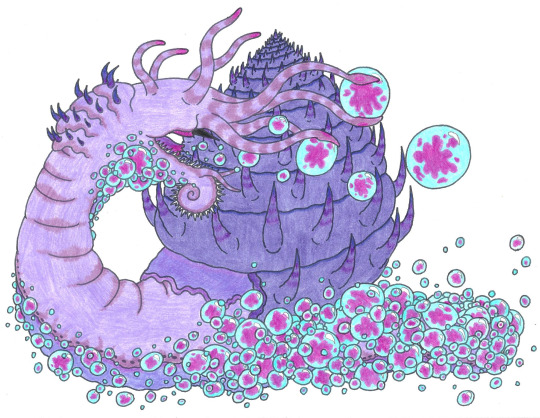
Back in my entry about the Lou Carcolh, I made mention that the species was often referred to as "Snail Dragons." This is because they are massive snails that have a fearsome reputation and also because someone realized it has been quite awhile since we gave any terrible names to animals so why not start now? However, ever since I have written and shown that entry to others, I have had various people look to me in confusion and say "that doesn't sound like our Snail Dragons at all!" They then describe another giant snail monster but make mention of some pretty defining traits. To them, that is what a Snail Dragon is, not one that uses sticky tendrils like a mobile spider's web! And here lies one of the MANY issues that come from these names made for drama and the use of such horribly vague and unhelpful titles such as "Snail Dragon." Because it turns out plenty of other places use that name as well, but for different species. So when you say "Snail Dragon" you could actually be referring to multiple different creatures, and there is a high chance the person you are talking to has a different species in their head than you. This is why I have such an issue with names like this, because it never stops being annoying! I would very much like to pretend these terrible names don't exist, but I have to or else another idiot will come up to me and fill me in on a "fun fact" that I "missed." No, I left that detail out because it is utterly useless, but thanks for "correcting" me, random guy who thinks I don't know how to do my job. Tangents aside, I loathe "Snail Dragons" as a name because it hides the fact that it is referring to the Carcolh and that there are multiple different species of them. And with how fascinating these things get, it is a crime to water down these incredible species with such a bland name!
Now I guess I could say this entry is about a "Snail Dragon" or I could say that we will be talking about the Dreamveil Carcolh. Now which of those sound better? Just read that last one again: Dreamveil Carcolh. Goodness me, just one look at a name like that makes me want to rush out right now to go see one! What title! What a descriptor! It ignites the imagination! Wakes the audience up! If I was a Carcolh, I know which name I would like to be called! Even if I wasn't a snail, I think it would be pretty nice! Chlora "Dreamveil" Myron! Yowzas, what a title! But enough rambling on that! Let's get back to business!
The Dreamveil Carcolh is indeed a member of the Carcolh family, a group of large shelled mollusks with hefty appetite for meat. While the Lou Carcolh is known to live in temperate climates, the Dreamveil favors the more tropical side of things. Places with heat and humidity is where they roam, as it does well for their wet hides but also works out better for their particular talent. Dreamveils can be identified by their purple flesh and spiraling spiked shell, which no doubt makes them more visually striking compared to their drab cousins. Such gorgeous colors, but that is not all that makes them so well known in their regions!
I am sure you are wondering what the origin of their name is, as why is this species called "Dreamveil?" You will have half of the answer when you gaze upon a living specimen, as you will clearly see why they have the word "veil" in their title. Dreamveil Carcolhs may have a shell to hide their important bits, but they rather slither about with a cloak of bubbles clinging to their flesh! Pretty much the only time you will see a Dreamveil without them would be if they are extremely young or dead. Their bodies secrete a mucus that works well in forming and maintaining bubbles, while their maws are specially structured to spew them out. While they can easily create hundreds of tiny bubbles to shroud themselves with, the fangs on the roof of their mouth can also assist in forming even larger bubbles, injecting air into gobs of mucus. Their oral tendrils are specifically shaped to help hold and move these bubbles without popping them, so that they can maintain and clean their cloud-like veil. The bubbles are important to this species, as they are used for defense and offense, which may seem odd for such large beasts. They have huge spiky shells! How will a cloud of fragile bubbles protect them more than something sturdy like that? I'm sure many predators and people have thought the same thing, and then made the wrong move and never had the chance to think again...
If you are observing a far away, living Dreamveil, you may notice that many of their bubbles have a strange hue to them. At first most think it is their purple flesh that is being seen through these transparent spheres, but no, there is something in those bubbles. I would say take a closer look, but that is a terrible idea, so just imagine with me here. If one could peer within, they would see a purplish cloud inside these bubbles, contained within the fragile shell. If one were to then pop said bubble, they would then get the whiff of something bitter and then....well, nothing else. The thing is, that purple gas has a purpose, and it is to knock out anything that inhales it. The "dream" part of their name comes from the fact that they create and use a sleep gas that is incredibly potent, and they wield it by putting it into bubbles. You can see it when a Dreamveil inflates a large bubble with its fangs, as the purple gas is injected within. Rather then just spray it around with reckless abandon, containing it within these spheres helps them store it for later and create a surprisingly effective armor! Sure, the bubbles won't stop a slashing claw, but the gas released from their destruction will put the attacker down right quick! This is what I mean by defense, as nothing can get close to a Dreamveil without the worry of popping a bubble and succumbing to the sleep gas. And as I said before, the Carcolh also uses this stuff as a weapon too...
While another of its kind uses oral tendrils for ambushing, the Dreamveil turns to its sleeping bubbles to take down its prey. They don't quite lie in wait like the Lou Carcolh, as they will actively seek out and stalk prey. However, they don't attack their food right out in the open, instead relying on a few well blown bubbles. When a Dreamveil has spotted its victim, it will use its fangs to blow up bubbles best fit for their target. It appears that the snail can assess the situation and will know what kind of bubbles will be needed to get the job done. The size of their prey determines how much gas is needed, the distance and surroundings will play into how strong the bubble will need to be to reach the right spot for detonation. When the bubbles are made, the oral tendrils will push them off into the wind, even fanning them with its own breath to help them fly to their destination. If the Dreamveil planned it all perfectly, the bubbles will float over to the unsuspecting victim and pop, releasing the gas within. Once breathed in, the sleeping gas will do its work and the prey will struggle against its tranquilizing effects. If a light amount is used, the target is groggy and struggles to move, while heavy doses can drop prey outright. As long as their victim is sufficiently immobilized, the Dreamveil can slither up and seize them in its tendrils. Further doses can finish the job and their nasty radula will carve through flesh as the snail feeds. Creepily enough, most victims die in their sleep, their minds never aware of the fact that they are being eaten alive. Those still awake will find that struggling only quickens their fate, as every flailing limb will just pop more bubbles and release more gas. With this powerful drug on their side, Dreamveil Carcolhs are rightfully feared by every creature in the environment and avoided at all costs.
Such an ability makes them infamous to the locals as well, as humans can wind up on the menu if they catch a whiff of that gas. The number of conflicts between the people and the Dreamveils are countless, as the snails fear no enemy. With the sleeping gas on their side, they believe themselves invincible and able to take what they please. They will target the livestock of farmers for an easy meal, using their bubbles to knock out the entire herd. Those who seek to stop them will have to do so from afar, as getting too close means a quick trip to dreamtown. Battles between the two don't just happen to protect homes and livelihoods, as Dreamveils are also hunted for their goods. The purple flesh can be used to create beautiful dyes that in turn make fabulous clothing. The great shell of theirs is an impressive trophy, and can also be broken down to be used in carving trinkets, jewelry and ornaments. And, of course, the sleep gas of a Dreamveil is wildly sought for its tranquilizing abilities. Some use it for knocking out beasts as well, as slayers find it perfect for taking down larger threats like dragons. Others enjoy it for medicinal purposes, able to knock patients out in an instant or gain restful sleep despite pain or other problems. I have heard of assassins using the gas to take down targets at perfect moments to create lethal "accidents." A quick puff of the stuff during bath time can easily lead to one falling asleep in the tub and drowning within the soapy suds. I have also heard that some groups use the gas in rituals to see the future or glimpse into the world of dreams. It is mixed with other drugs and materials to send someone on an incredible mental journey, which may result in some otherworldly knowledge or just give them some wonky dreams. Never tried the stuff myself, mainly because I fear what my writing would look like after such a trip and Eucella would never let me hear the end of it if she saw it. Goodness, I already get enough grief about my writing when I am focused and sober, can't imagine the reaming I would get if I were to go off on some crazed tangents that have nothing to do wi- OH NO MY INTRO!
Chlora Myron
Dryad Natural Historian
---------------------------------------------------------------
“Dreamveil Carcolh”
Because you can't just stop at one snail dragon species ya know...
25 notes
·
View notes
Text
Pokémon of the Week!
#706-A: Hisuian Goodra!
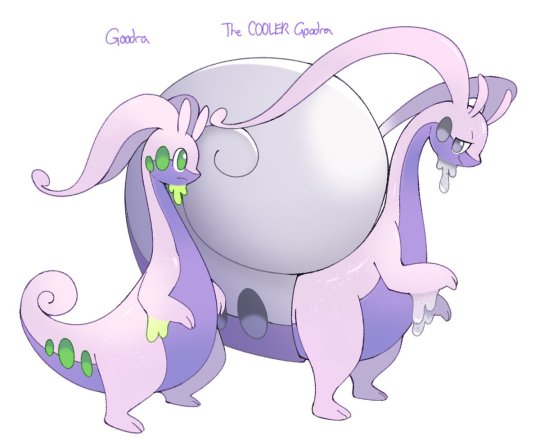
Welcome, nerds, to Pokémon of the Week!
Where I, Sesh, generate a random Pokemon to highlight each week!
With last week's inaugural post being about our slimy dragon friend, Goodra, I figured this week could be about Goodra's regional variant from Pokémon: Legends Arceus.
If you'd like to view that post, you can find it below!
I figure I can do this whenever I do a Pokémon of the Week post about a Pokémon that have regional forms. To me, they aren't the same as their "vanilla" counterparts and are different Pokémon all together that deserve their own posts. So here we are!
Hisuian Goodra is a fairly new Pokémon, only appearing in the latest installment, Legends Arceus. As such, there is a pretty limited amount of information on it. But I will try my best to give it the attention it deserves!
...because, like...out of all the Pokémon a feudal Sinnoh region would have in it, it'd be a jacked-up version of the slime dragon from Kalos...it shocked me when I first ran into it. It really did.
But it was a pleasant surprise.
Mostly.
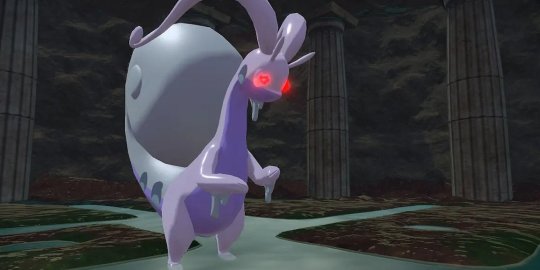
#alphagoodra #takesnoprisoners
So, as before, let's dive right in!
~ORIGINS~
As stated above, Hisuian Goodra debuted and has only appeared this year in Pokémon: Legends Arceus, a game that takes the player back in time to an ancient Sinnoh region (the region from the Diamond & Pearl games) that was then called the Hisui region.
Unlike vanilla Goodra, which is a pure Dragon-type, Hisuian Goodra adds the Steel-type into the mix, making it a wall to try and take down.
Right off the bat from the introduction image up top, you can tell that Hisuian Goodra is a big boi. Bigger than it's Kalosian counterpart, that's for sure. It's gotta be that big to support that MASSIVE snail-like shell that now adorns it's back.

As I stated in last week's post, Goodra could possibly be inspired by an eldritch horror from French folklore called Lou Carcolh (don't ask me how to pronounce that...), a giant, man-eating snail that supposedly lived in caves along the shores of France.
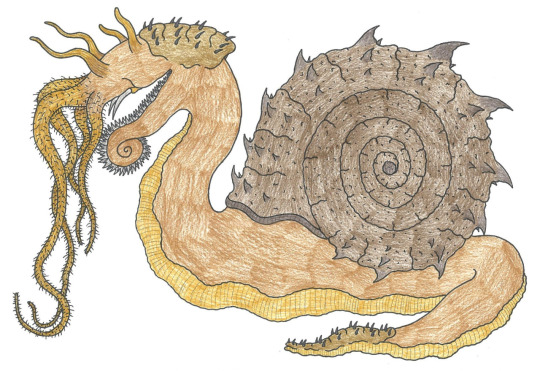
Again...oi...
This depiction of the beast has a shell on it's back, and this tracks with Hisuian Goodra's addition of a shell.
Hisuian Goodra could also be based on a deep-sea snail called a scaly-foot gastropod, which would make sense considering (according to Bulbapedia) this particular snail's shell consists of iron-sulfide compounds. That would explain the Steel-typing it has gained.
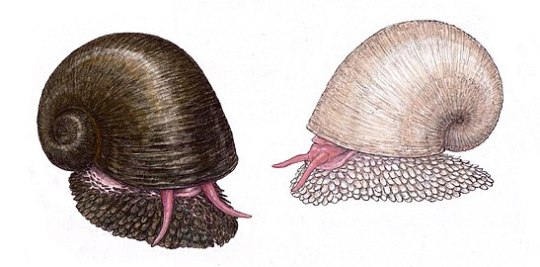
So, essentially, we have ourselves a bigger eldritch snail monster made of metal...
But, like normal Goodra...
At least it's f r i e n d l y ...
Maybe too friendly.
According to the only Pokedex entry it has from Legends Arceus, it "loathes solitude" and is "extremely clingy".
That checks as a Goodra...
BUT
It also says it will "fume and run riot if those dearest to it ever leave its side."
...
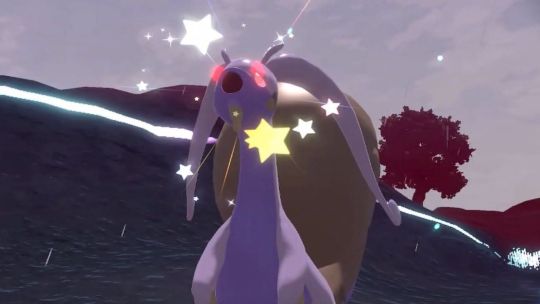
Ok...so the "jealous girlfriend" version of Goodra. Got it.
I'm seriously having PTSD flashbacks to the Alpha Hisuian Goodra boss fight in the game...and now it makes too much sense.
The dex also says it is able to control the hardness of it's shell. That's pretty neat! And useful defensively.
~DESIGN~
Here's the official Hisuian Goodra artwork:

Quoted from Hisuian Goodra's biology section on Bulbapedia:
"Hisuian Goodra has droopy, gray eyes and horns that are longer and thinner than Kalosian Goodra's horns. It sports a large, spiral-shaped metallic shell on its back, which it can tuck its body into to protect itself, leaving only its head outside of the shell to observe its surroundings. It can control the hardness of its shell at will. It has fewer gray spots than Kalosian Goodra, with one on each side of its cheek and two on each side of its shell. From its chin and arms drips a metallic gray slime. Hisuian Goodra has a clingy disposition and hates being alone; it will become angry and run riot if its closest companions leave its side."
~ADVANTAGES~
With it's dual-typing of Dragon and Steel, normal Goodra's Ice and Fairy-type woes are are gone, instead doing normal damage. It is also, as I said, A WALL of defense. It's Steel-typing makes it completely immune to Poison-type attacks, and is resistant to twice the amount of types as normal Goodra.
According to Bulbapedia, Hisuian Goodra and Hisuian Sliggoo are the only known Pokémon that can learn the move "Shelter", which increases Goodra's defense and evasiveness at the same time. Dang.
With it's added Steel-typing, Hisuian Goodra can now be a more effective dragon slayer; meaning, Dragon-type moves are no longer Super Effective against it.
Unlike regular Goodra (which is very squishy), Hisuian Goodra's Defense is higher. It's Special Defense remains that same highest state, so field Hisuian Goodra against heavy special attack users.
~DISADVANTAGES~
It's a BEEG BOI. Meaning it's slooooooow. Slower than slow. Slower than normal Goodra. It's lowest base stat is speed, so don't field Hisuian Goodra against speedy bois.
Though it's Steel-typing is mainly an advantage, Hisuian Goodra is now weak to Fighting and Ground-type moves.
~HOW TO OBTAIN~
As I've said already, Hisuian Goodra is brand new and is only obtainable in Pokémon: Legends Arceus. You can obtain this massive steel death snail for yourself in 2 ways:
Catch yourself a Goomy or Hisuian Sliggoo in the wild of either the Crimson Mirelands (at the Holm of Trials or during mass outbreaks in Ursa's Ring) or at the Ancient Quarry in the Coronet Highlands. Like normal Goomy, is will evolve into Hisuian Sliggoo at level 40 and finally into Hisuian Goodra at level 50 when it is raining. NOTE: It is possible to catch a Hisuian Sliggoo in Alpha form, so be on the lookout for those red eyes of death.

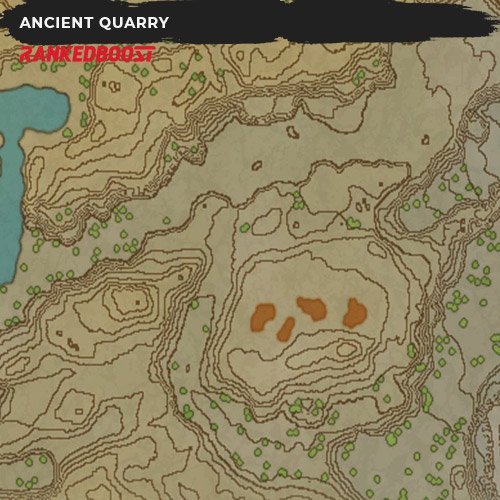
If you don't want to trouble yourself with evolving it's pre-evolved forms and go straight for the prize of a massive murder snail, there are 2 places you catch them directly (but ONLY in Alpha form...so, you know...good luck...) As part of the story, you encounter an Alpha Hisuian Goodra in the cavern of Lake Verity (PTSD for me...first one I encountered). That is the only time you can try to catch that one. If you knock it out, too bad. It's gone. You can catch that one if you're lucky. But don't worry! If you're very lucky, fate may smile on you and generate an Alpha Hisuian Goodra for you to battle and (maybe) catch with it's Goomy and Sliggoo brethren at the Ancient Quarry in the Coronet Highlands.
~COOL HISUIAN GOODRA FANART~
The freakos on the Internet aren't as weird about Hisuian Goodra as they are about vanilla Goodra, so this delve into fanart wasn't as mentally-scarring as last week. Here are some cool pics of our steel murder snail!
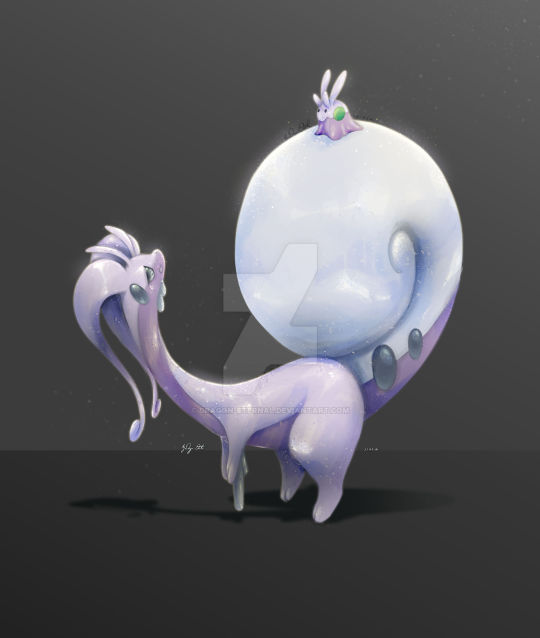
D'aww...with a li'l Goomy on his shell.

A cartoony version enjoying splashing in the mud (I assume)...
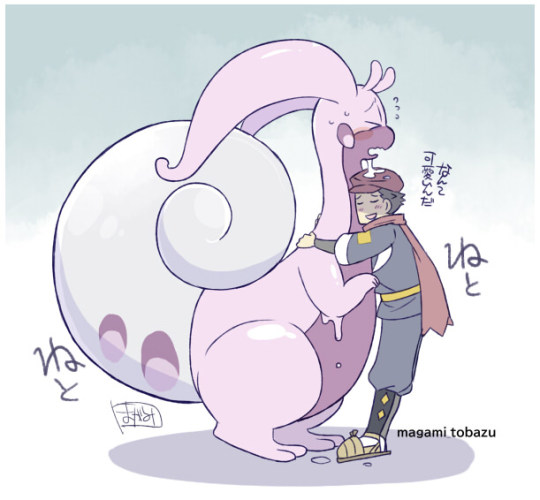
Ah yes. Wouldn't be a Goodra without the trademark slimy hug. :)

Here they all are! The Hisuian Goodra crew!

Guh...this is adorable. I can't even.
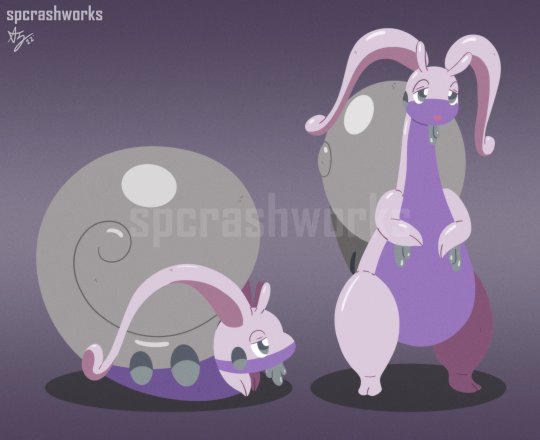
IT CAN GO INTO IT'S SHELL. #myheart
~CONCLUSION~
Hisuian Goodra was a welcome regional variant for me to discover as I traversed the game of Legends Arceus. I know a lot of people out there aren't fans of the regional variants (and I can agree somewhat with some of them... *coughAlolanPersiancough* But THIS? It's a good aesthetic change and a good typing and play-type change for our slimy dragon friend while maintaining it's friendly demeanor. I was pleasantly surprised by it.
...but also terrified. Alpha Hisuian Goodra still haunts my dreams.
Let me know your thoughts on Hisuian Goodra!
Until next time! See you next week for an OG water pupper!

#pokemon highlight#pokemon of the week#funny content#review#gaming#nerd talks#pokemon#hisuian goodra#hisuian sliggoo#goomy#pokemon fanart#fanart#legends arceus#nintendo switch#advantages#disadvantages#where to obtain
38 notes
·
View notes
Text
We’re getting French in this entry in my series where I cover the origins of every aquatic Pokémon not based on a fish because its gen VI time! For previous entries in this series see gen I part 1, gen I part 2, gen II, gen III, gen IV, and gen V. For the previous series where I cover all the fish Pokémon, see here. As before, starters and legendaries/mythicals will be saved for their own posts.
We only just started and I want to stop because it’s the Binacle line. By Arceus these things are hideous. That kind of fits though, because they’re based on goose barnacles, which aren’t exactly lookers themselves. I previously discussed barnacles here, but in short, they are filter-feeding crustaceans that incase themselves in hard shells that they will stay in for life. Goose barnacles differ from the more common acorn barnacles because they attach to rocks or other hard surfaces via a thick, muscular stalk.
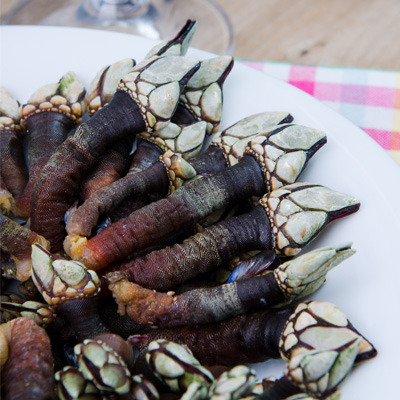
(image: goose barnacles)
Binacle’s shell is expanded to look like a hand with the face in it. Because two binnacle live together on the same rock they seem to be a case of intraspecific symbiosis, as opposed to the more common intraspecific symbiosis. Barbaracle is seven barnacles living together on two rocks, where they now take a humanoid shape. It retains the goose barnacle inspiration but now I think it also takes inspiration from mecha stories where multiple smaller mechs can combine into a larger one, such as in Voltron. In addition, the non-head barnacles are reduced to a single hand with an eye in the palm, which could reference the hamsa, a common symbol in North Africa and the Middle East.
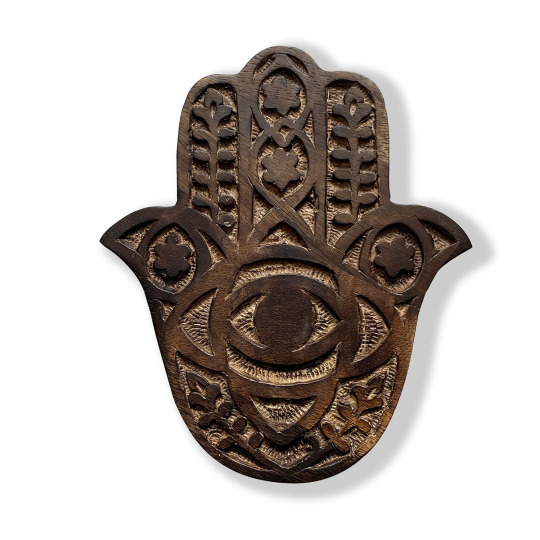
(image: a hamsa)
Clauncher and Clawitzer are based on pistol shrimp. These shrimp, members of the family Alpheidae, are known for their asymmetrical claws which they can use to create jets of water and a large snapping sound. The large claw has a chamber within it. When the claw is opened, water will rush into the chamber. The claw can then be snapped shut to pressurize the water enough to create a cavitation bubble and a light emission called sonoluminescence. The pressure forces the water out of the chamber with enough speed and pressure to kill small fish. The whole process takes less than a millisecond and produces a loud snapping sound. The shrimp use the snapping for communication and hunting. They will wait for fish to swim close, then shoot water at them to stun or kill them. Clauncher’s method of powering its water jets is different. It uses controlled release of internal gas. In addition, it uses the water jets to move around and hunt. It is said to shoot flying Pokémon out of the air with its water jets, probably a reference to how the archerfish will knock insects out of the air by spitting water at them. In both the real shrimp and the Pokémon, the claws will grow back if severed. There’s a lot more cool stuff about pistol shrimp I could go over but they aren’t really relevant to Clauncher and I think I’ll save hem for a future Wet Beast Wednesday post.
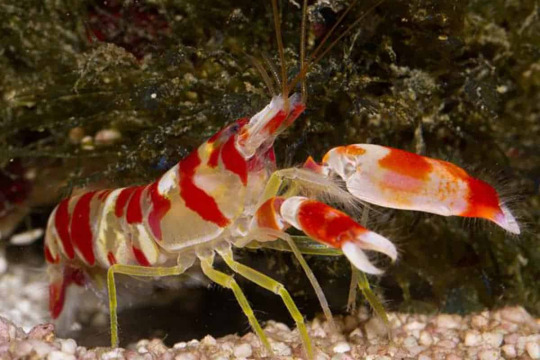
(image: a pistol shrimp)
I debated whether or not I should count the Goomy line as aquatic or not but I decided I will because it lives in swamps and will die if it dries out, so I will. Also I just can’t say no to Goomy. The line are based on slugs and a French legendary creature called Lou Carcolh that was said to be a slimy serpent or dragon with hairy tentacles and a large shell.
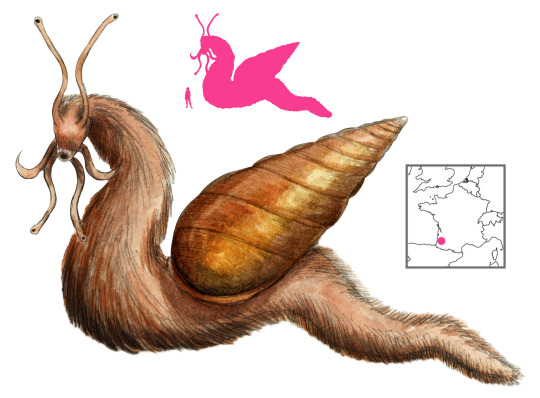
(image: a depiction of Lou Carcolh from the blog A Book of Creatures. Check it out, its cool)
Lou Carcolh was a malevolent creature that would grab people with its tentacles and drag them in to devour them. This line is much friendlier. They are likely a combination of land and sea slugs, likely nudibranchs due to their bright coloration. The horns they have are based on the eye stalks of the land slug and the tentacle-like rhinopores of the sea slug.

(image: a blue sea slug)
Like slugs, they are covered with a layer of slime that keeps them wet. Slugs must stay wet to survive and therefore prefers wetlands or shady areas, much like Goomy. Sliggoo is based on a semi-slug, which are intermediate gastropods between snails and slugs. They still have a shell, but it is too small for them to retract into it and in many species it is covered by the mantle, effectively making it an internal shell.
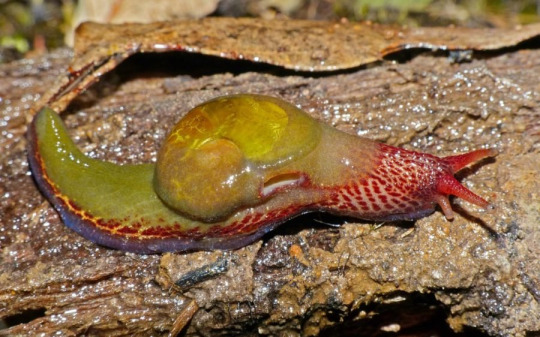
(image: a semi-slug)
In contrast to their modern counterparts, Hisuian Sliggoo and Goodra are snails. Their shells are metallic and come from living in mineral-rich waters. They are specifically based on the scaly-foot gastropod, which is a deep-sea snail which has a shell and part of its foot made of iron sulfides.
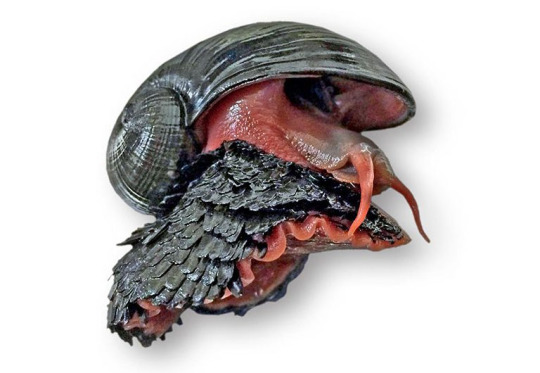
(image: the scaly-foot gastropod)
They are also likely based on shussebora, a yokai that is a trumpet shell snail that turned into a dragon after living for 1000 years each in the mountains, plains, and sea.
If you asked me if the Bergmite line was aquatic I would have said no. There is nothing in their descriptions or locations in the game that would imply they live in water. That is until Scarlet and Violet let them swim. It makes some sense, as they are based on icebergs, but it’s still a curveball after 3 generations of them living on mountains or in icy caves. But yeah, they’re icebergs, large chunks of ice that float freely in the water. Bergmite is based more specifically on the top part of the iceberg, which is much smaller than the part that remains underwater. Avalugg is based more on the submerged part of the iceberg. It is also based on a tortoise. It being compared to an aircraft carrier might reference Project Habakkuk, a plan in World War II to make an aircraft carrier out of pykrete, a combination of wood pulp and ice that is resistant to melting. They never actually did it, though.

(image: an iceberg. No I'm not using the famous iceberg picture)
With that, gen VI comes to a close. Join me next time when we head to the tropics for gen VII.
#pokemon#pokemon lore#pokemon biology#biology#marine biology#zoology#animal facts#binacle#barbaracle#clauncher#clawitzer#goomy#sliggoo#goodra#bergmite#avalugg#acorn barnacle#barnacles#pistol shrimp#slug#sea slug#semi slug#scaly foot snail#lou carcolh#iceberg
5 notes
·
View notes
